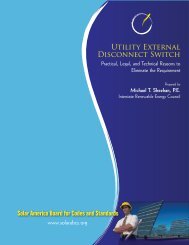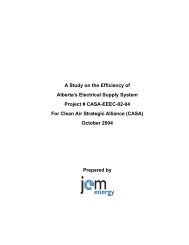Worldwatch Institute
Worldwatch Institute
Worldwatch Institute
You also want an ePaper? Increase the reach of your titles
YUMPU automatically turns print PDFs into web optimized ePapers that Google loves.
Jumpstarting a Revolution<br />
If a low-carbon energy economy is possible,<br />
the next question is how we get there<br />
from here. The road ahead will be long<br />
and expensive, but it has become a bit<br />
clearer thanks to the trailblazing initiatives of<br />
pioneering governments and companies over<br />
the past few years. A successful transition will<br />
nonetheless require a powerful combination<br />
of government policy changes, steady technological<br />
progress, and the rechanneling of private<br />
investment.<br />
It is instructive to remember that when oil<br />
was first discovered in western Pennsylvania in<br />
the 1860s, it was virtually useless—far more<br />
expensive than coal and, prior to the development<br />
of the refinery or internal combustion<br />
engine, useless for transportation. Even as<br />
crude oil became widely used for lighting in the<br />
late 19th century, the idea that it would become<br />
a dominant energy source—let alone reshape<br />
the global economy—was inconceivable.<br />
In 1907, only 8 percent of U.S. homes had<br />
electricity, Henry Ford had produced about<br />
3,000 vehicles in his four-year-old factory, and<br />
the mass-produced Model T wasn’t yet introduced.<br />
1 Similarly, when Thomas Edison introduced<br />
his improved lightbulb, skeptics<br />
dismissed it: “Everyone acquainted with the<br />
subject will recognize it as a conspicuous failure,”<br />
said the president of the Stevens<br />
<strong>Institute</strong>. 2 Few would have imagined that by<br />
the mid-20th century, virtually every American<br />
home—and billions of others around the<br />
world—would have electricity and lighting,<br />
and that the automobile would redefine<br />
lifestyles and the economy.<br />
Most economic transitions begin as almost<br />
imperceptible ripples that build into transformative<br />
waves. Dominant technologies and<br />
businesses are protected by a network of institutional<br />
and political support that effectively<br />
resists change. As a result, developers of new<br />
technologies and businesses must start by finding<br />
a niche market to exploit, meeting specialized<br />
needs at a higher cost. But over time, the<br />
new competitor becomes more economical<br />
and widens its share of the market, eventually<br />
undercutting the cost of the dominant player<br />
and gradually remolding the institutional<br />
infrastructure to meet its own needs. The<br />
transition from one generation of technology<br />
to another speeds up as the economic advantage<br />
flips.<br />
According to conventional wisdom, the<br />
energy sector is far from such a transformation.<br />
New renewable energy sources, including<br />
solar, wind, geothermal, and biomass, represent<br />
less than 4 percent of the total energy<br />
supply, and in 2008 total U.S. government support<br />
of renewable energy research and development<br />
(R&D) came to little more than $650<br />
million—about the amount the government<br />
spent in Iraq in a single day. 3 What these figures<br />
fail to capture is the recent infusion of<br />
private-sector capital and technology and the<br />
fact that today’s renewable energy pioneers are<br />
not limited to “energy technology” but rather<br />
draw on fields as diverse as semiconductor<br />
physics, biotechnology, aerodynamics, and<br />
computer engineering.<br />
Rapid growth has turned the new energy<br />
industries into lucrative businesses, with<br />
demand outrunning supply and profits soaring.<br />
An estimated $71 billion was invested in<br />
new renewable electric and heating capacity in<br />
2007, up from just $20 billion in 2002. 4 (See<br />
w w w . w o r l d w a t c h . o r g L O W - C A R B O N E N E R G Y : A R O A D M A P 29









